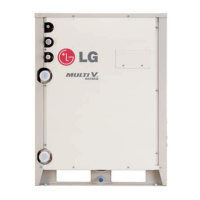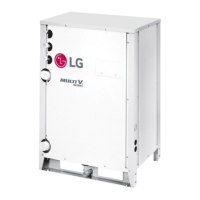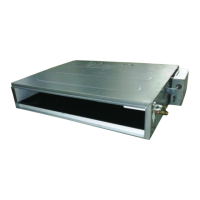57
Refrigerant Piping
Due to our policy of continuous product innovation, some specifications may change without notification.
©LG Electronics U.S.A., Inc., Englewood Cliffs, NJ. All rights reserved. “LG” is a registered trademark of LG Corp.
REFRIGERANT PIPING INSTALLATION
Pipe Bends
When bending soft copper, use long radius bends. Refer to Table 46 for minimum radius specifications.
In-line Refrigeration Components
Components such as oil traps, solenoid valves, filter-dryers, sight glasses, tee fittings, and other after-market accessories are not permitted
on the refrigerant piping system between the water source units and the indoor units. Multi V Water Source Unit systems have redundant
systems that assure oil is properly returned to the compressor. Sight-glasses and solenoid valves may cause vapor to form in the liquid
stream. Over time, dryers may deteriorate and introduce debris into the system. The designer and installer should verify the refrigerant pip-
ing system is free of traps, sagging pipes, sight glasses, filter dryers, etc.
Field-Provided Isolation Ball Valves
LG maintains a neutral position on using isolation valves in VRF refrigerant piping systems. LG does not endorse any manufacturer of isola-
tion valves. It is recognized that installing isolation valves may simplify future maintenance requirements, and, if used, considerations should
be taken including, but not limited to, the following:
• Pressure drops for any component used, including isolation valves, must be known in equivalent pipe length and calculated into the
total and segment equivalent piping lengths and compared to product design limitations.
• In all cases, materials must be suitable for the application and any applicable codes, including, but not limited to, diameter and wall
thickness continuity per ACR standards.
Failure to do so may cause significant performance degradation. Proper leak checks must be performed. Using isolation valves does not
automatically void any LG product warranty; however, a limited warranty may be voided in whole or part should any field supplied accessory
fail in any way that causes product failure.
Using Elbows
Field supplied elbows are allowed as long as they are designed for use with R410A refrigerant. The designer and installer, however, should be
cautious with the quantity and size of ttings used, and must account for the additional pressure losses in equivalent pipe length calculation for each
branch. The equivalent pipe length of each elbow must be added to each pipe segment in the LATS program. See Table 40 for equivalent lengths.
Installation of Refrigerant Piping/Brazing Practice
It is imperative to keep the piping system free of contaminants and debris such as copper burrs, slag, or carbon dust during installation.
1. All joints are brazed in the field. Multi V Water Source Unit refrigeration system components contain very small capillary tubes, small
orifices, electronic expansion valves, oil separators, and heat exchangers that can easily become blocked. Proper system operation
depends on the installer using best practices and utmost care while assembling the piping system.
• Store pipe stock in a dry place; keep stored pipe capped and clean.
• Blow clean all pipe sections with dry nitrogen prior to assembly.
2. Proper system operation depends on the installer using best practices and the utmost care while assembling the piping system.
• Use adapters to assemble different sizes of pipe.
• Always use a non-oxidizing material for brazing. Do not use flux, soft solder, or
anti-oxidant agents. If the proper material is not used, oxidized film may accu-
mulate and clog or damage the compressors. Flux can harm the copper piping or
refrigerant oil.
• Use a tubing cutter to cut pipe; do not use a saw. De-bur and clean all cuts before
assembly.
3. Brazing joints:
• Use a dry nitrogen purge operating at a minimum pressure of three (3) psig and
maintain a steady flow.
• Use a 15% silver phosphorous copper brazing alloy to produce good flow and
avoid overheating.
• Protect isolation valves, electronic expansion valves, and other heat-sensitive control components from excessive heat with a wet rag or
heat barrier spray.
Figure 29:Refrigerant Pipe Brazing.
Pressure-reducing
Valve
Valve
Taping
Nitrogen
Pipe to
be brazed
Piping

